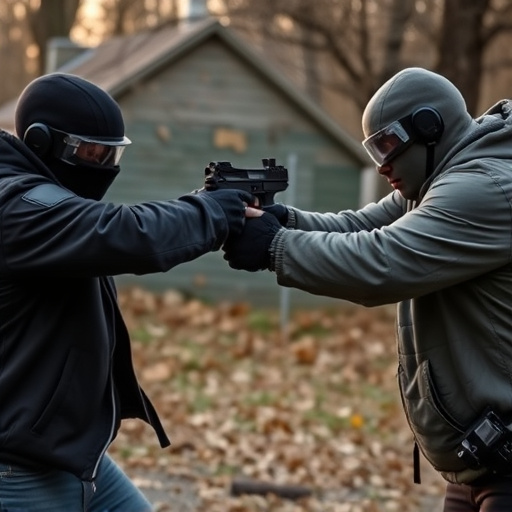The text discusses tactical stun gun holsters designed for non-lethal self-defense and law enforcement, emphasizing the Neuromuscular Effects of Stun Devices as a key consideration. Users need secure yet easy access to their stun devices, with holsters featuring adjustable retention, quick-draw capabilities, and durable materials like Kydex or leather. Popular options include belt holsters and pocket holsters, with tactical mag holsters for backup magazines. Material, design, and attachment method are crucial factors, balancing security and ease of use while catering to diverse user needs, from everyday carry to specialized tactical situations.
“Tactical stun gun holsters are essential accessories for personal safety and defense. Understanding the neuromuscular disruption caused by stun devices, which temporarily incapacitates an attacker through targeted muscle overstimulation, is key to choosing the right holster. This article explores various tactical options, from belt-mounted designs to innovative custom solutions. We’ll delve into factors like material, attachment methods, and advanced features, guiding you in selecting a holster that not only conceals your stun gun effectively but also provides comfort and reliable performance, ensuring you’re prepared for any unexpected situation.”
- Understanding Neuromuscular Disruption: How Stun Devices Work
- Types of Tactical Stun Gun Holsters: An Overview
- Factors to Consider When Choosing a Stun Gun Holster
- Material and Design: Key Features for Comfort and Concealment
- Attachment Methods: Belts, Clips, and More
- Advanced Options: Customization and Additional Features
Understanding Neuromuscular Disruption: How Stun Devices Work
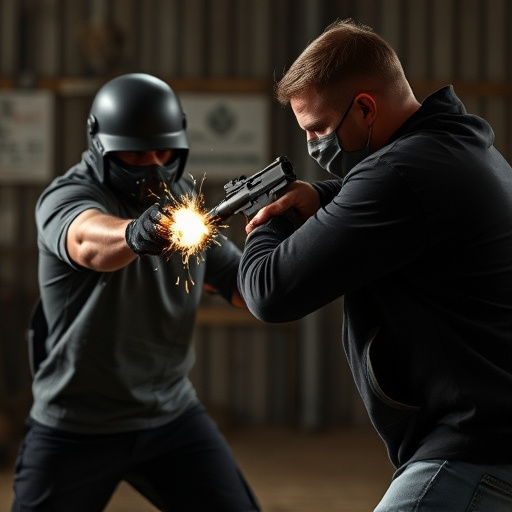
Stun guns, or electroshock weapons, disrupt neuromuscular function to temporarily incapacitate a target. They achieve this by delivering a strong electrical pulse that overrides the body’s natural nerve signals, causing muscles to contract uncontrollably. This sudden and intense disruption leads to a loss of balance, disorientation, and a significant reduction in physical ability.
The neuromuscular effects of stun devices are designed to be non-lethal but highly effective for self-defense or law enforcement applications. By disrupting communication between nerves and muscles, these devices enable users to gain time and distance from potential threats, providing a crucial window for escape or the arrival of backup.
Types of Tactical Stun Gun Holsters: An Overview
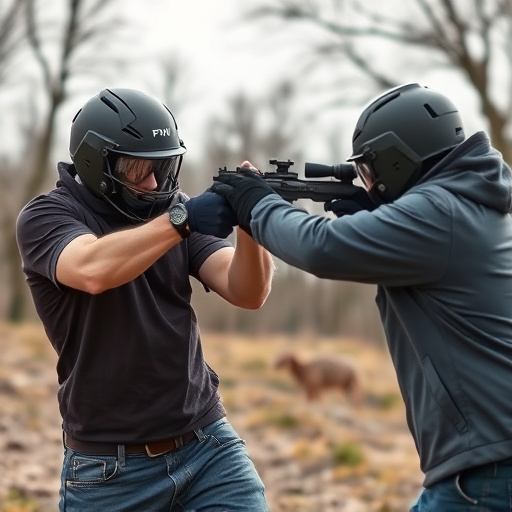
Tactical stun gun holsters are designed to cater to a range of needs, from everyday carry to law enforcement applications. These holsters offer specialized features such as adjustable retention, quick-draw capabilities, and durable construction, ensuring users can access their stun device efficiently and securely. One popular type is the belt holster, which attaches to a wearer’s duty belt, providing easy accessibility while keeping the device close at hand.
Another option is the pocket holster, designed for discreet carry in a pants or jacket pocket. This style is ideal for those who prefer a low-profile approach, while still offering quick deployment. For those in need of more advanced protection, tactical mag holsters can be attached to a belt or vest, providing additional storage for backup magazines and enhancing the overall defensive capability. Moreover, understanding the neuromuscular effects of stun devices—like temporary muscle paralysis—is crucial when selecting a holster, as it influences the design and placement for optimal control and safety.
Factors to Consider When Choosing a Stun Gun Holster

When selecting a stun gun holster, several key factors come into play. Firstly, consider the fit and compatibility with your specific stun gun model. Different devices have varying dimensions and shapes, so ensuring the holster accommodates your stun gun snugly is essential. The draw mechanism is another critical aspect; opt for a design that allows for a smooth, quick draw, as this can make all the difference in high-pressure situations.
Moreover, the type of material used in construction significantly impacts both comfort and durability. High-quality holsters often incorporate materials like Kydex or leather, each offering unique advantages. For instance, Kydex is known for its lightweight yet robust nature, while leather provides a classic, durable option. Additionally, think about your personal preferences regarding belt loops or pocket styles, as these will affect carrying comfort and accessibility. Remember, the neuromuscular effects of stun devices can be significant, so choosing a well-designed holster that enhances control and ease of use is paramount for effective self-defense.
Material and Design: Key Features for Comfort and Concealment

When selecting a tactical stun gun holster, material and design are paramount for both comfort and concealment. Opting for high-quality materials like kydex or leather ensures durability and longevity, crucial factors in a dependable holster. These materials also offer superior shape retention, allowing for precise molding around your stun gun, which is essential for effective neuromuscular effects of stun devices.
The design should prioritize comfort without compromising concealment. A well-designed holster with adjustable belts or clips enables easy attachment and secure holding, enhancing accessibility during emergencies. Additionally, a slim profile ensures minimal bulk, making it less noticeable under clothing, vital for discreetly carrying your stun gun in various settings.
Attachment Methods: Belts, Clips, and More
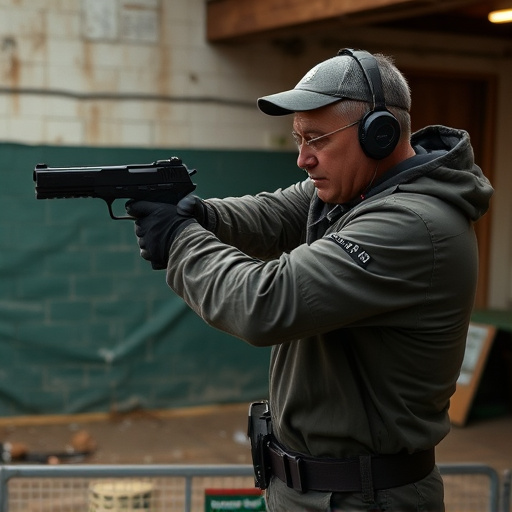
When considering tactical stun gun holster options, one key aspect to explore is the attachment method. Traditional belt holsters offer a secure and reliable way to carry your stun device, especially those designed for everyday carry (EDC). This method leverages the sturdy construction of belts, allowing for easy access while ensuring the stun gun remains firmly in place. Alternatively, clip-based holsters provide convenience for rapid deployment, as they attach directly to clothing or gear. These clips can be spring-loaded or adjustable, catering to various pant styles and sizes.
Beyond belts and clips, several other attachment methods deserve mention, particularly for those seeking specialized options. Mag-lock systems utilize magnetic force to secure the stun gun, offering quick release and re-attachment features. This is especially beneficial in tactical scenarios where speed and efficiency are paramount. Additionally, some holsters incorporate molle or webbing systems, enabling versatile attachment to duty belts, vests, or even backpacks, accommodating diverse carrying preferences while enhancing operational readiness. The Neuromuscular Effects of Stun Devices play a crucial role in these discussions, as users must select holsters that not only secure the device but also facilitate easy activation during high-stress situations.
Advanced Options: Customization and Additional Features
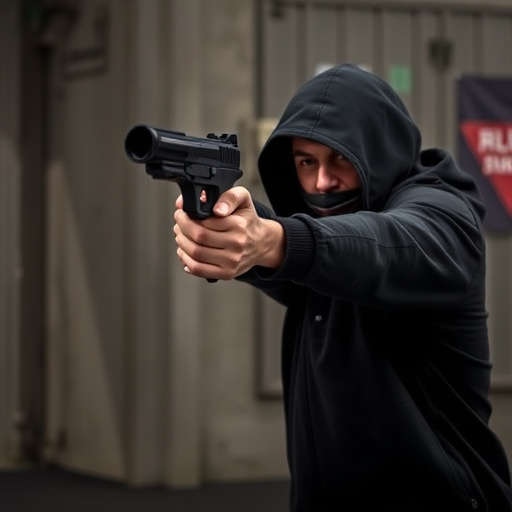
When exploring tactical stun gun holster options, advanced users often look beyond standard models to find solutions tailored to their specific needs. Customization and additional features are key aspects that set apart top-tier holsters from the rest. Many manufacturers offer personalized options, allowing users to integrate their stun guns seamlessly into their unique operational requirements. This might include specialized materials for different environments, adjustable fittings for various body types, or even built-in safety mechanisms for enhanced control during high-pressure situations.
Furthermore, some advanced holsters incorporate features that go beyond basic protection. These could range from LED lights for improved visibility in low-light conditions to impact-resistant designs capable of withstanding extreme forces. Understanding the neuromuscular effects of stun devices is crucial here; a well-designed holster should not only secure the weapon but also minimize recoil, ensuring better control and accuracy during use. Such thoughtful additions can make all the difference in real-world scenarios, offering users an edge in safety and effectiveness.
When selecting a tactical stun gun holster, consider not just concealment and comfort but also the neuromuscular disruption these devices cause. In understanding how stun guns work—disrupting nerve signals through electrical impulses—you can make an informed choice that aligns with your needs. The right holster should offer secure attachment methods, whether belts, clips, or advanced customization, ensuring easy accessibility during emergencies. By balancing functionality, comfort, and the device’s neuromuscular effects, you’ll find a suitable holster for personal safety.
